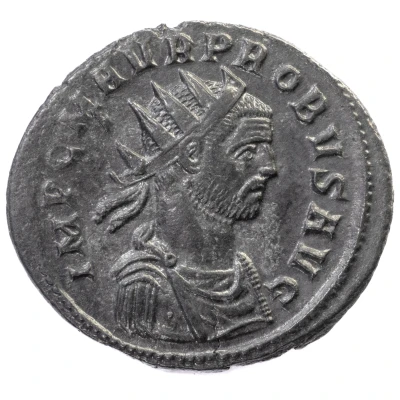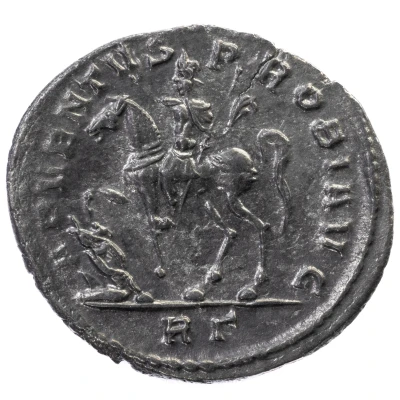


Antoninianus - Probus Cuirassed, left, sword resting on left arm; ADVENTVS PROBI AVG
| Silver | 3.7 g | 21.5 mm |
| Issuer | Rome › Roman Empire (27 BC - 395 AD) |
|---|---|
| Emperor | Probus (Marcus Aurelius Probus) (276-282) |
| Type | Standard circulation coin |
| Years | 277-278 |
| Value | Antoninianus (1) |
| Currency | Antoninianus, Reform of Caracalla (AD 215 – 301) |
| Composition | Silver |
| Weight | 3.7 g |
| Diameter | 21.5 mm |
| Shape | Round (irregular) |
| Technique | Hammered |
| Orientation | Variable alignment ↺ |
| Demonetized | Yes |
| Updated | 2024-10-05 |
| Numista | N#293383 |
|---|---|
| Rarity index | 100% |
Reverse
Probus, riding left, raising right hand and holding sceptre in left hand; at his feet, captive.
Mintmark (sometimes followed by officina or ✶ and officina) in exergue.
Scripts: Latin, Greek
Lettering: ADVENTVS PROBI AVG
Unabridged legend: Adventus Probi Augusti.
Translation: Adventus (Roman welcoming ceremony) of emperor Probus.
Comment
The original RIC text lists RIC 161 as minted by the 4th (RΔ, R✶Δ), the 6th (R✶ς) and 7th (R✶Z) officina and mentions 5 bust types (bust types according to Pierre Bastiens grouping of bust types; see illustrated: probvs.net). There are two know (*) variants:
- Radiate, cuirassed, right (B bust, Guillemain (*) #83 (R), #215 (RΔ), #271 (R✶Δ), #298 & #307 (R✶Z), example: probuscoins #4470, Numista #294702);
- Radiate, cuirassed, right, with spear (F9 bust, Guillemain #78 (R), #126 (RΓ), #142 (RΔ), #163 (Rς), example: probuscoins #2344, Numista #414305);
- Helmeted, radiate, cuirassed, left, with spear and shield (E1 bust; no example on probuscoins, Numista #293381);
- Radiate, wearing imperial mantle, left, holding sceptre surmounted by eagle in right hand (bust H2, Guillemain #161 (RЄ), #294 (R✶ς), no example on probuscoins, Numista #293382);
- Radiate, cuirassed, left, hand holding sword resting on left arm (I11 bust, Guillemain -, example: probuscoins #3324 , Numista #293383);
- [var] Draped, right (A bust, Guillemain #75 (R), #100 (-), #128 (RΓ), #145 (RΔ), #165 (Rς), #179 (RZ), example: probuscoins #2356, Numista #414306);
- [var] Radiate, cuirassed, left, holding spear (F5 bust, Guillemain #91 (R), example: probuscoins #4589, not in Numista).
(*) Guillemain also lists an "I8" bust (#93 (R), #175 (Rς)), being: Laureate bust, left cuirassed, holding a pugio in the left hand and a Nicephore globe in the right. See: Jean Guillemain, La Monetazione di Probo a Roma (276-282), Ripostiglio della Venèra-Nuovo Catalogo Illustrato Vol III/1, 2009. No example of this bust has been published.
The variants (A and F5 bust) are a variant of RIC 161 because that is the only coin of the Rome mint with the obverse legend nr. 1 ('IMP C M AVR PROBVS AVG'), the reverse legend 'ADVENTVS PROBI AVG' and on the reverse Probus, on horse left, raising right hand and sceptre in left hand, with captive at foot.
According to both Guillemain and Pink, RIC 161 is part of the 2nd emission (exergue-/mint mark style: -/-//Rς; year 277) and 3rd emission (-/-//R✶ς; year 278). See Guillemain 2009 and Karl Pink, Der Aufbau der römischen Münzprägung in der Kaiserzeit VI/I, Wien, 1949, p. 55-56.
Pink only lists the 4th (RΔ, R✶Δ), 6th (R✶ς) 7th (R✶Z) officina and the mintmark 'R' without officina mark. As is clear by the examples listed on probuscoins, RIC 161 was not only minted during the 3rd emission by the 6th (R✶ς) and 7th (R✶Z) officina but also during the 2nd emission (6th: Rς; 7th: RZ). Guillemain also lists that RIC 161 was minted by the 3rd (RΓ) and 5th (RЄ) officina during the second emission, which for the 3rd (RΓ) is confirmed by an example on probuscoins (#664) and the example listed on Numista for the A bust.
Interesting fact
The Antoninianus - Probus coin was part of a series of coins issued during the reign of Emperor Probus (276-282 AD) to celebrate his military victories and agricultural reforms. The coin's design features the emperor in military attire, with a cuirassed (armored) bust and a sword resting on his left arm, symbolizing his military prowess. The Latin inscription "ADVENTVS PROBI AVG" means "The arrival of Probus Augustus," highlighting his title as Augustus, which was a honorific title given to Roman emperors. This coin is made of silver and weighs 3.7 grams, which was a significant weight for a coin at that time. It's a testament to the advanced metallurgical techniques of the Roman Empire, which allowed them to produce high-quality coins that were used for trade and commerce throughout their vast territories. Overall, the Antoninianus - Probus coin is an interesting piece of history that provides insight into the military and economic achievements of the Roman Empire during the 3rd century AD.

